New Delhi, Jan 29 (IANS) Turning a decades-old dogma on its head, Indian-origin scientists at University of California-San Francisco and Stanford Medicine shows that the receptor for oxytocin, a hormone considered essential to forming social bonds, may not play the critical role that scientists have assigned to it for the past 30 years. In the 15-years-long study, published in the journal Neuron, the team found that prairie vole animals bred without receptors for oxytocin and showed the same monogamous mating, attachment, and parenting behaviors as regular voles. In addition, females without oxytocin receptors gave birth and produced milk, though in smaller quantities, than ordinary female voles. The results indicate that the biology underlying pair bonding and parenting is not purely dictated by the receptors for oxytocin, sometimes referred to as the "love hormone." "While oxytocin has been considered 'Love Potion #9,' it seems that potions 1 through 8 might be sufficient," said psychiatrist Devanand Manoli, a senior author of the paper and member of the UCSF Weill Institute for Neurosciences. "This study tells us that oxytocin is likely just one part of a much more complex genetic programme," he added. Because prairie voles are one of the few mammalian species known to form lifelong monogamous relationships, researchers study them to better understand the biology of social bonding. The current project emerged from shared interests between Manoli and co-senior author and neurobiologist Nirao Shah, now at Stanford Medicine. For this study, the two applied new genetic technologies to confirm if oxytocin binding to its receptor was indeed the factor behind pair bonding. They used CRISPR to generate prairie voles that lack functional oxytocin receptors. Then, they tested the mutant voles to see whether they could form enduring partnerships with other voles. To the researchers' surprise, the mutant voles formed pair bonds just as readily as normal voles. "The patterns were indistinguishable," said Manoli. "The major behavioural traits that were thought to be dependent on oxytocin - sexual partners huddling together and rejecting other potential partners as well as parenting by mothers and fathers - appear to be completely intact in the absence of its receptor." Even more surprising for Manoli and Shah than the pair bonding was the fact that a significant percentage of the female voles were able to give birth and provide milk for their pups. Oxytocin is likely to have a role in both birth and lactation, but one that is more nuanced than previously thought, Manoli said. The results help to clear up some of the mystery surrounding the hormone's role in childbirth: Oxytocin is commonly used to induce labour but blocking its activity in mothers who experience premature labor isn't better than other approaches for halting contractions. When it came to producing milk and feeding pups, however, the researchers were taken aback. The discovery points the researchers down new paths to improving the lives of people struggling to find social connection. "If we can find the key pathway that mediates attachment and bonding behaviour," Shah said, "We'll have an eminently druggable target for alleviating symptoms in autism, schizophrenia, and many other psychiatric disorders."
Is oxytocin a 'love hormone'? Indian-origin researchers raise questions
- by Rinku
- January 29, 2023 2 minutes

Is oxytocin a 'love hormone'? Indian-origin researchers raise questions.











